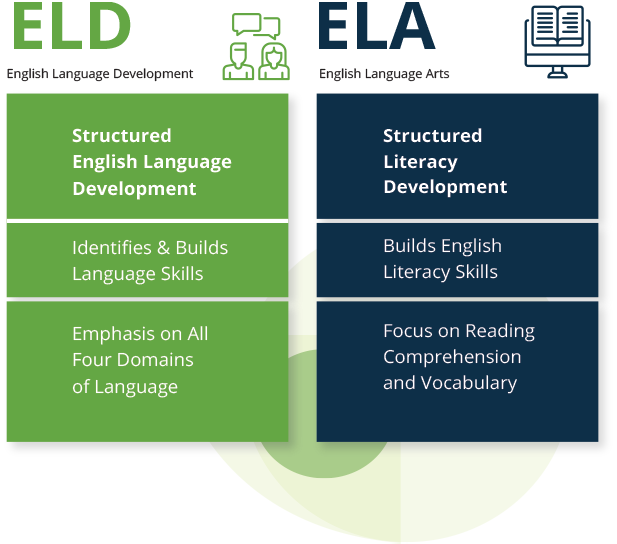Integrated ELD Is Not Enough: Why An ELA Curriculum Alone Doesn’t Fully Serve Our English Learners
When I first entered the classroom almost 20 years ago, I taught English Language Arts (ELA) to a group of middle school students who, by today’s standards, would have been formally classified as Long-Term English Learners (LTELs). This was during the height of the No Child Left Behind (NCLB) period when state standardized testing was the clear priority. Teachers were pressed to focus on test-taking strategies for reading comprehension, writing essays, and open-ended responses. We did this through less-than-meaningful activities to prepare students for standardized testing.
While I knew my students needed explicit instruction and ample practice in foundational English skills, I was only allotted 15 to 20 minutes daily to address English language instruction. In hindsight, my mini-lessons in grammar or vocabulary would only benefit students already familiar with the skill. Not my struggling LTELs. As you can probably guess, the lack of a solid foundation in English affected their growth in other subject areas as well as their performance on state exams.

English Learners Still Need to Learn Foundational Language Skills
I now realize that language acquisition is a complex journey, especially for English Language Learners (ELLs) who are entering the U.S. educational system past their formative years. Older ELLs especially need focused English language instructional time together with age-appropriate resources that build foundational language skills – including phonics, phonological awareness, and word knowledge. However, with the teaching of phonics and phonemic awareness being nearly nil in a middle or high school literacy program, there’s an even more pressing need for a language development curriculum.
Often, at the secondary level, educators are more inclined to put the three Rs – Reading, wRiting, and aRithmatic – on a pedestal. While learning content through the various disciplines is wildly important, ELLs need instruction around listening, speaking, writing structure and the foundational skills previously mentioned, with additional time to practice these skills.
What About the ELD Resource Embedded in ELA Curriculum?

As the ELL population grows across the United States, administrators and educators selecting instructional resources for English learners must understand that many ELA programs that claim to include an English Language Development (ELD) component may not be sufficient. They often do not provide enough explicit instruction along with appropriate scaffolding and support for English learners. They function mostly as refreshers similar to the mini-lessons I delivered in my ELA. They assume the student has already learned the language skill at some point. This is certainly not the case with many Newcomer students. Even LTELs may not have had instruction in certain language areas.
As standalone resources, the tacked-on ELD components are inadequate in actually teaching new language skills. Unfortunately, they often appear to be “afterthoughts” in the curriculum development process (with no clear connection to the content).
What to Look For Instead
An effective ELD curriculum is holistic, standards-based, and addresses all four domains of language with ample opportunities to practice collaboratively and independently. It’s important to point out that, unlike ELA tools, the focus of ELD tools is language, not content. For example, the “big idea” or “plot” of a reading passage is less important than how the author uses words, sentence construction, and other techniques in writing a passage to further a purpose (e.g., to explain, to persuade, to argue, etc.). ELD tools help English learners better understand language's purpose in order to effectively manipulate language according to audience, context, and situation. These language skills can then be leveraged across all their academic subjects.
ELD tools should be leveled and standards-based to ensure comprehensive, equitable instruction and to support our students' journey to becoming fully proficient listeners, speakers, readers, and writers in the English language. They should include assessments based on the standards so educators are aware of individual language strengths and weaknesses. The resources should explicitly teach the language skill gaps identified.
Finally, effective ELD resources need to be holistic. To be relevant and therefore engaging, they should address the “whole student”, taking into account a student’s culture, age, previous experiences, and background knowledge.
In Conclusion
It’s important to recognize that integrated ELD in the Language Arts classroom prioritizes literacy goals over language acquisition. This is not the teacher’s fault. There is only so much time that can be allocated to teaching language concepts to a subset of students. Additionally, most “ELD” materials joined to an ELA curriculum are lightweight and minimally effective because they assume that English learners have pre-existing knowledge.
In an ideal world, there would be ample focused time for language development. Whether or not this “designated ELD” time exists on students’ schedules, English learners and their teachers should be supported with the right resources and tools. These resources would be standards-based, offer explicit instruction, and provide multiple opportunities for ELLs to explore the English language through speaking, listening, reading, and writing.
Educators can bridge the opportunity gap and create a more equitable learning environment if they receive the tools and knowledge needed to help English learners redesignate and take full advantage of their academic experiences.
"Older ELLs especially need focused English language instructional time together with age-appropriate resources that build foundational language skills – including phonics, phonological awareness, and word knowledge."
 About the Author
About the Author
Mary Purcell is a certified teacher and administrator in the states of New Jersey and Delaware with a Master’s in Educational Leadership and School Business Administration. She spent the better part of a decade teaching Literacy, History, and Health to middle school English Language Learners in an inclusion classroom. With a passion for education, she is an active contributor to Language Tree Online. For more information, connect with her on LinkedIn.